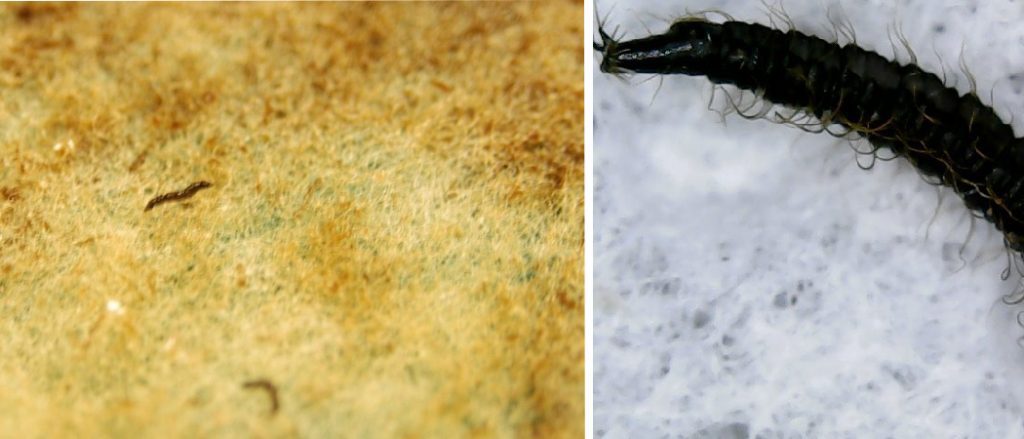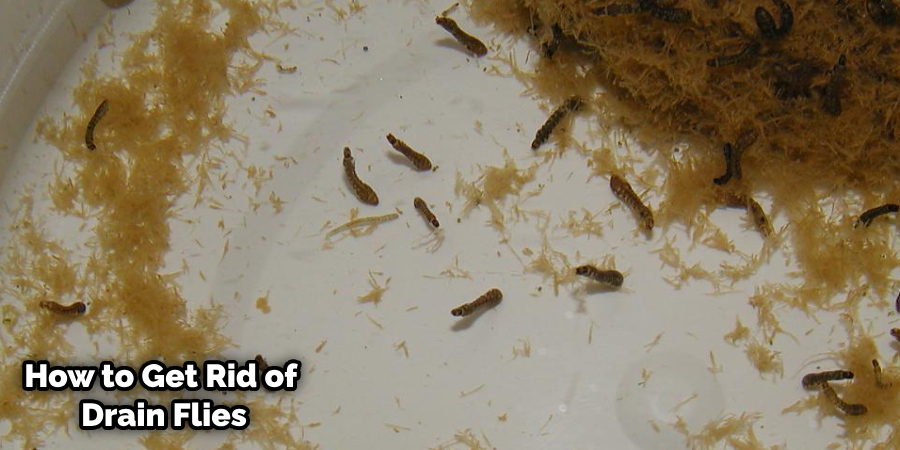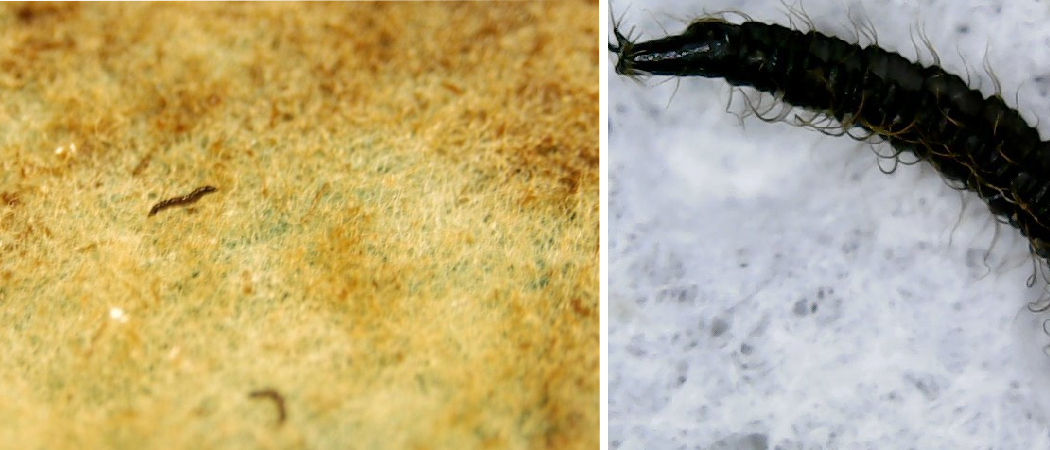Drain fly larvae can sometimes find their way into a fish tank, as they are commonly found in areas with standing water and organic matter. Although these larvae do not directly harm the tank’s inhabitants, they can still be a nuisance since they feed on bacteria that help to keep the tank clean. To get rid of the drain fly larvae, start by cleaning out any debris or rotting food from the bottom of the tank and changing 25% of the water while vacuuming up any waste on top of the gravel. Maintaining a clean and healthy environment for your fish is paramount for their well-being. However, fish tank owners occasionally encounter unexpected challenges, such as the presence of drain fly larvae. These tiny, wriggling creatures can be alarming, but understanding their origin, potential risks, and effective removal methods is crucial. In this blog post, we’ll explore the reasons behind the appearance of drain fly larvae in your fish tank and provide comprehensive information on how to deal with this issue effectively.
Then use an aquarium filter that has a fine mesh media so it can catch all particles including small drain fly larvae before being released back into your aquarium. Finally, you may also want to use some kind of biological control agent like Bacillus thuringiensis israelensis which will help kill off any remaining larvae without harming fish or other aquatic life in your aquarium.

Having Drain Fly Larvae in a fish tank can be quite alarming for any aquarium hobbyist. Not only do these larvae look unsightly, but they can also threaten your fish’s health if left untreated. Taking quick action to eradicate them is key to keeping your tank clean and healthy, so it’s important to identify the source of the infestation and take steps to remove them safely.
How to Get Rid Of Drain Flies in Your Aquarium
Why Are Drain Fly Larvae in Your Fish Tank?
The presence of drain fly larvae in a fish tank can be puzzling, especially considering that these insects are typically associated with stagnant water in drains, sewers, or decaying organic matter. However, several reasons can explain their appearance in your fish tank:
- Contaminated Water Sources: If you use untreated water sources or don’t properly clean and treat new aquatic plants or decorations before adding them to your tank, drain fly larvae might hitch a ride.
- Overfeeding: Excess fish food that remains uneaten can accumulate at the bottom of the tank, creating a breeding ground for drain fly larvae and other pests.
- Poor Tank Maintenance: Inadequate cleaning and maintenance can lead to the accumulation of organic debris, which serves as a food source for drain fly larvae.
- Infested Aquarium Gravel or Substrate: If the gravel or substrate in your tank was previously infested with drain fly larvae, they could multiply in the aquarium environment.
How Do I Get Rid of Drain Fly Larvae in My Fish Tank?
When it comes to dealing with drain fly larvae in a fish tank, the best approach is to remove them manually. This can be done by using a net or vacuum cleaner. If you opt for the latter option, make sure that you only use a tube made specifically for aquarium use not to suck up any of your fish and other aquatic life.
Additionally, it would be best if you also looked into changing the water in your tank regularly to prevent future infestations from occurring. Finally, if all else fails, there are various chemical treatments available from pet stores that may help eradicate these pesky larvae.
Can Drain Fly Larvae Live in Water?
Yes, drain fly larvae can live in water. Drain flies typically lay their eggs near the edges of wet surfaces such as sinks and bathtubs. When the eggs hatch, they form small larvae that quickly wiggle to find a nearby water source to hide and feed on organic material like microorganisms.
The larvae can survive submerged in shallow waters for up to two weeks before maturing into adult flies. Drain fly infestations often occur when stagnant water accumulates, providing an ideal environment for these pests to thrive.
Are Drain Fly Larvae Harmful?
No, drain fly larvae are not harmful to humans. However, their presence near drains and sewers can be a nuisance in and around the home. They feed on organic material that accumulates in these areas, such as hair, grease, or food waste.
Although the larvae do not bite or transmit any diseases directly to humans, they can serve as vectors for disease-causing organisms like salmonella and E. coli if inadvertently ingested when present in large numbers. It is essential to keep drains clean and free of debris to prevent an infestation of drain fly larvae from occurring. Additionally, insecticides may be used to control the population of this species when necessary.
Why are There Larvae in My Fish Tank?
Larvae in a fish tank are usually caused by an infestation of mosquito larvae. Mosquitoes lay their eggs in standing water, which can quickly accumulate in any fish tank that isn’t regularly cleaned and maintained. Larvae can also be introduced to the aquarium through live plants or from other sources such as ponds, streams, and even infected store-bought fish.
To combat this problem, you should keep your tanks clean and well-maintained with regular water changes; if possible, use a filter system designed specifically for removing larvae; avoid introducing contaminated items into the aquarium; and consider using a larvicide to kill off existing larvae populations.

Credit: www.myaquariumclub.com
Can Fish Eat Drain Fly Larvae?
Yes, fish can eat drain fly larvae as part of their diet. Drain fly larvae are a nutritious snack for fish, providing them with essential proteins and minerals. In addition, these larvae in an aquarium can help keep the water clean by consuming organic waste that accumulates on the tank bottom.
How to Get Rid of Gnats in Fish Tank?
If you have a fish tank, it is important to ensure that gnats don’t take over. The best way to eliminate gnats in your fish tank is by removing any decaying organic matter from the tank and cleaning the gravel, filters, and decorations regularly. You can also use an appropriate insecticide or larvacide to kill off any remaining insects.
Lastly, ensure no cracks or openings in your aquarium where gnats could enter from outside sources!
Mosquito Larvae in Fish Tank
Mosquito larvae can often be found in fish tanks, as they need a water source to lay their eggs. They feed on organic waste and debris, so if you have a lot of that in your tank it could attract them. Mosquito larvae are harmless to fish, but they can spread diseases like malaria and Zika virus, making controlling the population important.
It’s best to keep your tank clean and free from any standing water or other food sources for mosquitoes to prevent an infestation.
Can Drain Flies Lay Eggs in Humans?
No, drain flies cannot lay eggs in humans. They can, however, bite humans and feed on their blood. These small flies are typically found near drains, sewers, cesspools, and other sources of polluted water or organic matter that provide the ideal breeding ground for them to lay their eggs.
Why are There Little Flies in My Fish Tank?
Small flies in your fish tank are most likely Fungus Gnats, which can easily get into the tank and lay their eggs in moist soil or decaying organic matter. These pests feed on algae, fungi, and decomposing leaves and will not harm your fish; however, they can cause problems such as blocking light from reaching the bottom of the aquarium. To prevent these gnats from getting into your tank, keep the lid on tight when doing maintenance work (like cleaning) and cover any openings with mesh or fine netting material.
Additionally, ensure that you regularly remove dead plant matter so there is no food source for them.
How to Get Rid of Drain Fly Larvae?
The best way to get rid of drain fly larvae is to use mechanical and chemical methods. Start by cleaning the areas around the drains with hot water, vinegar, and baking soda. This will kill any existing larval populations as well as remove any organic debris that could be providing them with food sources.
Then follow up with products like insecticides or bacterial larvicides specifically designed for killing drain flies. Finally, reduce excess moisture in your home by fixing leaks and using dehumidifiers.
How to Get Rid of Drain Flies?

Drain flies, also known as moth flies or sewer gnats, are a type of small flies that can invade your home and create an annoying nuisance. To get rid of drain flies, it is important to clean the drains where they breed by pouring boiling water down them and scrubbing the sides with a stiff brush. You should also pour bleach or vinegar into the pipes to kill any eggs that may be present.
Additionally, you can use insecticides such as aerosol sprays or dust to target adult drain flies directly.
Potential Risks to Your Fish
While drain fly larvae themselves may not pose a direct threat to your fish, they can indirectly harm your aquatic pets. The presence of these larvae often indicates poor water quality and hygiene, which can lead to various issues such as:
- Altered Water Chemistry: The decomposition of organic matter by drain fly larvae can alter the water chemistry, leading to fluctuations in pH levels and affecting the overall balance of the aquarium ecosystem.
- Disease and Infections: The introduction of pests like drain fly larvae can increase the risk of diseases and infections among your fish. Unhealthy tank conditions can weaken fish immune systems, making them more susceptible to illnesses.
- Stress and Discomfort: Fish are sensitive creatures, and changes in their environment, including the presence of unwanted larvae, can cause stress and discomfort, leading to behavioral issues and potential health problems.
Drain Flies in Turtle Tank
Drain flies, also known as moth flies, are a common nuisance in turtle tanks. These tiny insects feed off organic matter that builds up in stagnant water and can lay eggs in the tank. To prevent an infestation of drain flies, it’s important to keep your turtle tank clean by regularly changing out the water and removing any debris or uneaten food.
Additionally, you can use chemical treatments like insecticides or larvacides to help reduce their numbers if needed.
Preventive Measures for the Future
Preventing the recurrence of drain fly larvae or any other pests in your fish tank is essential for the well-being of your aquatic pets. Here are some preventive measures to consider:
- Quarantine New Additions: Quarantine any new fish, plants, or decorations in a separate tank before introducing them to your main aquarium. This precautionary step allows you to observe and treat any potential pest issues before they can affect your established tank.
- Regular Tank Inspections: Conduct regular inspections of your fish tank to identify and address any issues promptly. Early detection can prevent infestations from escalating.
- Proper Feeding Habits: Feed your fish in moderation, ensuring they consume all the food within a few minutes. Remove any uneaten food promptly to prevent it from decomposing and attracting pests.
- Maintain Good Hygiene: Regularly clean your tank, including the substrate and decorations. Vacuum the gravel during water changes to remove organic debris that can serve as food for pests.
- Use Quality Water Sources: Use clean, treated water from reliable sources for your fish tank. Avoid using untreated tap water, as it may contain contaminants that can lead to pest infestations.
Conclusion
Overall, drain fly larvae in a fish tank is not something to take lightly. It is important to be aware of the signs and symptoms that can indicate their presence and take steps to get rid of them as soon as possible. They can quickly overrun an aquarium if left unchecked, leading to poor water quality and unhealthy fish.
Taking simple preventative measures such as keeping tanks clean, using a filter regularly, and avoiding overfeeding will help reduce the chances of encountering these pests in your tank.


